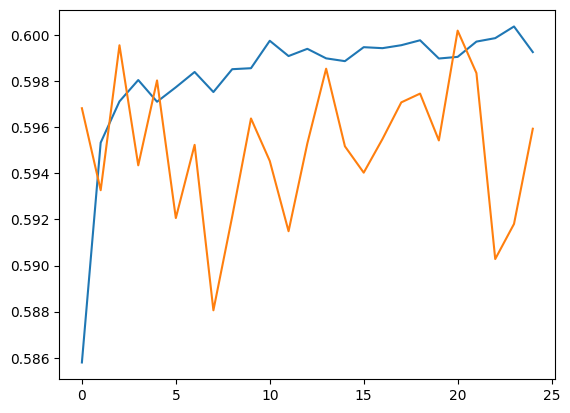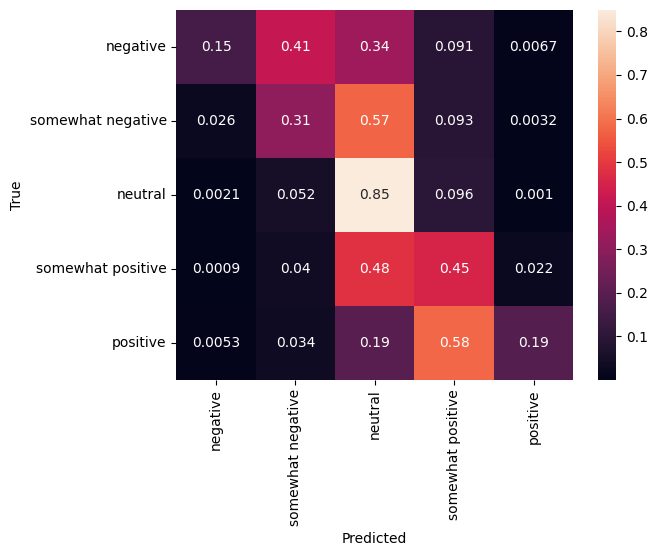 Xem trên TensorFlow.org Xem trên TensorFlow.org |  Chạy trong Google Colab Chạy trong Google Colab |  Xem trên GitHub Xem trên GitHub |  Tải xuống sổ ghi chép Tải xuống sổ ghi chép |  Xem mô hình TF Hub Xem mô hình TF Hub |
TF-Hub là một nền tảng để chia sẻ kinh nghiệm học máy đóng gói trong các nguồn tài nguyên tái sử dụng, đặc biệt là các module trước được đào tạo. Trong hướng dẫn này, chúng tôi sẽ sử dụng mô-đun nhúng văn bản TF-Hub để đào tạo một bộ phân loại tình cảm đơn giản với độ chính xác cơ sở hợp lý. Sau đó, chúng tôi sẽ gửi các dự đoán cho Kaggle.
Đối với hướng dẫn chi tiết hơn về việc phân loại văn bản với TF-Hub và các bước tiếp theo để cải thiện tính chính xác, hãy nhìn vào phân loại văn bản với TF-Hub .
Thành lập
pip install -q kaggle
import tensorflow as tf
import tensorflow_hub as hub
import matplotlib.pyplot as plt
import numpy as np
import pandas as pd
import seaborn as sns
import zipfile
from sklearn import model_selection
Kể từ hướng dẫn này sẽ sử dụng một bộ dữ liệu từ Kaggle, nó đòi hỏi phải tạo ra một API Mã cho tài khoản Kaggle của bạn, và tải lên nó vào môi trường Colab.
import os
import pathlib
# Upload the API token.
def get_kaggle():
try:
import kaggle
return kaggle
except OSError:
pass
token_file = pathlib.Path("~/.kaggle/kaggle.json").expanduser()
token_file.parent.mkdir(exist_ok=True, parents=True)
try:
from google.colab import files
except ImportError:
raise ValueError("Could not find kaggle token.")
uploaded = files.upload()
token_content = uploaded.get('kaggle.json', None)
if token_content:
token_file.write_bytes(token_content)
token_file.chmod(0o600)
else:
raise ValueError('Need a file named "kaggle.json"')
import kaggle
return kaggle
kaggle = get_kaggle()
Bắt đầu
Dữ liệu
Chúng tôi sẽ cố gắng để giải quyết vấn Phân tích Niềm tin vào Movie Nhận xét nhiệm vụ từ Kaggle. Bộ dữ liệu bao gồm các cụm từ con theo cú pháp của các bài phê bình phim trên Rotten Tomatoes. Nhiệm vụ là nhãn các cụm từ là tiêu cực hoặc tích cực đối với quy mô 1-5.
Bạn phải chấp nhận các quy tắc cạnh tranh trước khi bạn có thể sử dụng API để tải về dữ liệu.
SENTIMENT_LABELS = [
"negative", "somewhat negative", "neutral", "somewhat positive", "positive"
]
# Add a column with readable values representing the sentiment.
def add_readable_labels_column(df, sentiment_value_column):
df["SentimentLabel"] = df[sentiment_value_column].replace(
range(5), SENTIMENT_LABELS)
# Download data from Kaggle and create a DataFrame.
def load_data_from_zip(path):
with zipfile.ZipFile(path, "r") as zip_ref:
name = zip_ref.namelist()[0]
with zip_ref.open(name) as zf:
return pd.read_csv(zf, sep="\t", index_col=0)
# The data does not come with a validation set so we'll create one from the
# training set.
def get_data(competition, train_file, test_file, validation_set_ratio=0.1):
data_path = pathlib.Path("data")
kaggle.api.competition_download_files(competition, data_path)
competition_path = (data_path/competition)
competition_path.mkdir(exist_ok=True, parents=True)
competition_zip_path = competition_path.with_suffix(".zip")
with zipfile.ZipFile(competition_zip_path, "r") as zip_ref:
zip_ref.extractall(competition_path)
train_df = load_data_from_zip(competition_path/train_file)
test_df = load_data_from_zip(competition_path/test_file)
# Add a human readable label.
add_readable_labels_column(train_df, "Sentiment")
# We split by sentence ids, because we don't want to have phrases belonging
# to the same sentence in both training and validation set.
train_indices, validation_indices = model_selection.train_test_split(
np.unique(train_df["SentenceId"]),
test_size=validation_set_ratio,
random_state=0)
validation_df = train_df[train_df["SentenceId"].isin(validation_indices)]
train_df = train_df[train_df["SentenceId"].isin(train_indices)]
print("Split the training data into %d training and %d validation examples." %
(len(train_df), len(validation_df)))
return train_df, validation_df, test_df
train_df, validation_df, test_df = get_data(
"sentiment-analysis-on-movie-reviews",
"train.tsv.zip", "test.tsv.zip")
Split the training data into 140315 training and 15745 validation examples.
train_df.head(20)
Đào tạo một người mẫu
class MyModel(tf.keras.Model):
def __init__(self, hub_url):
super().__init__()
self.hub_url = hub_url
self.embed = hub.load(self.hub_url).signatures['default']
self.sequential = tf.keras.Sequential([
tf.keras.layers.Dense(500),
tf.keras.layers.Dense(100),
tf.keras.layers.Dense(5),
])
def call(self, inputs):
phrases = inputs['Phrase'][:,0]
embedding = 5*self.embed(phrases)['default']
return self.sequential(embedding)
def get_config(self):
return {"hub_url":self.hub_url}
model = MyModel("https://tfhub.dev/google/nnlm-en-dim128/1")
model.compile(
loss = tf.losses.SparseCategoricalCrossentropy(from_logits=True),
optimizer=tf.optimizers.Adam(),
metrics = [tf.keras.metrics.SparseCategoricalAccuracy(name="accuracy")])
history = model.fit(x=dict(train_df), y=train_df['Sentiment'],
validation_data=(dict(validation_df), validation_df['Sentiment']),
epochs = 25)
Epoch 1/25 4385/4385 [==============================] - 16s 3ms/step - loss: 1.0237 - accuracy: 0.5869 - val_loss: 1.0023 - val_accuracy: 0.5870 Epoch 2/25 4385/4385 [==============================] - 15s 3ms/step - loss: 0.9995 - accuracy: 0.5941 - val_loss: 0.9903 - val_accuracy: 0.5952 Epoch 3/25 4385/4385 [==============================] - 15s 3ms/step - loss: 0.9946 - accuracy: 0.5967 - val_loss: 0.9811 - val_accuracy: 0.6011 Epoch 4/25 4385/4385 [==============================] - 15s 3ms/step - loss: 0.9924 - accuracy: 0.5971 - val_loss: 0.9851 - val_accuracy: 0.5935 Epoch 5/25 4385/4385 [==============================] - 15s 3ms/step - loss: 0.9912 - accuracy: 0.5988 - val_loss: 0.9896 - val_accuracy: 0.5934 Epoch 6/25 4385/4385 [==============================] - 15s 3ms/step - loss: 0.9896 - accuracy: 0.5984 - val_loss: 0.9810 - val_accuracy: 0.5936 Epoch 7/25 4385/4385 [==============================] - 15s 3ms/step - loss: 0.9892 - accuracy: 0.5978 - val_loss: 0.9845 - val_accuracy: 0.5994 Epoch 8/25 4385/4385 [==============================] - 15s 3ms/step - loss: 0.9889 - accuracy: 0.5996 - val_loss: 0.9772 - val_accuracy: 0.6015 Epoch 9/25 4385/4385 [==============================] - 15s 3ms/step - loss: 0.9880 - accuracy: 0.5992 - val_loss: 0.9798 - val_accuracy: 0.5991 Epoch 10/25 4385/4385 [==============================] - 15s 3ms/step - loss: 0.9879 - accuracy: 0.6002 - val_loss: 0.9869 - val_accuracy: 0.5935 Epoch 11/25 4385/4385 [==============================] - 15s 3ms/step - loss: 0.9878 - accuracy: 0.5998 - val_loss: 0.9790 - val_accuracy: 0.5985 Epoch 12/25 4385/4385 [==============================] - 14s 3ms/step - loss: 0.9871 - accuracy: 0.5999 - val_loss: 0.9845 - val_accuracy: 0.5964 Epoch 13/25 4385/4385 [==============================] - 15s 3ms/step - loss: 0.9871 - accuracy: 0.6001 - val_loss: 0.9800 - val_accuracy: 0.5947 Epoch 14/25 4385/4385 [==============================] - 15s 3ms/step - loss: 0.9873 - accuracy: 0.6001 - val_loss: 0.9810 - val_accuracy: 0.5934 Epoch 15/25 4385/4385 [==============================] - 14s 3ms/step - loss: 0.9865 - accuracy: 0.5988 - val_loss: 0.9824 - val_accuracy: 0.5898 Epoch 16/25 4385/4385 [==============================] - 15s 3ms/step - loss: 0.9865 - accuracy: 0.5993 - val_loss: 0.9779 - val_accuracy: 0.5974 Epoch 17/25 4385/4385 [==============================] - 15s 3ms/step - loss: 0.9866 - accuracy: 0.5991 - val_loss: 0.9785 - val_accuracy: 0.5972 Epoch 18/25 4385/4385 [==============================] - 15s 3ms/step - loss: 0.9863 - accuracy: 0.6001 - val_loss: 0.9803 - val_accuracy: 0.5991 Epoch 19/25 4385/4385 [==============================] - 16s 4ms/step - loss: 0.9863 - accuracy: 0.5996 - val_loss: 0.9773 - val_accuracy: 0.5957 Epoch 20/25 4385/4385 [==============================] - 15s 3ms/step - loss: 0.9862 - accuracy: 0.5995 - val_loss: 0.9744 - val_accuracy: 0.6009 Epoch 21/25 4385/4385 [==============================] - 15s 3ms/step - loss: 0.9861 - accuracy: 0.5997 - val_loss: 0.9787 - val_accuracy: 0.5968 Epoch 22/25 4385/4385 [==============================] - 15s 3ms/step - loss: 0.9855 - accuracy: 0.5998 - val_loss: 0.9794 - val_accuracy: 0.5976 Epoch 23/25 4385/4385 [==============================] - 14s 3ms/step - loss: 0.9861 - accuracy: 0.5998 - val_loss: 0.9778 - val_accuracy: 0.5966 Epoch 24/25 4385/4385 [==============================] - 15s 3ms/step - loss: 0.9860 - accuracy: 0.5999 - val_loss: 0.9831 - val_accuracy: 0.5912 Epoch 25/25 4385/4385 [==============================] - 14s 3ms/step - loss: 0.9858 - accuracy: 0.5999 - val_loss: 0.9780 - val_accuracy: 0.5977
Sự dự đoán
Chạy dự đoán cho tập xác thực và tập huấn luyện.
plt.plot(history.history['accuracy'])
plt.plot(history.history['val_accuracy'])
[<matplotlib.lines.Line2D at 0x7f62684da090>]

train_eval_result = model.evaluate(dict(train_df), train_df['Sentiment'])
validation_eval_result = model.evaluate(dict(validation_df), validation_df['Sentiment'])
print(f"Training set accuracy: {train_eval_result[1]}")
print(f"Validation set accuracy: {validation_eval_result[1]}")
4385/4385 [==============================] - 14s 3ms/step - loss: 0.9834 - accuracy: 0.6007 493/493 [==============================] - 1s 2ms/step - loss: 0.9780 - accuracy: 0.5977 Training set accuracy: 0.6006770730018616 Validation set accuracy: 0.5976500511169434
Ma trận hỗn loạn
Một thống kê rất thú vị, nhất là đối với những vấn đề nhiều lớp, là ma trận nhầm lẫn . Ma trận nhầm lẫn cho phép hình dung tỷ lệ các ví dụ được dán nhãn đúng và sai. Chúng ta có thể dễ dàng thấy trình phân loại của chúng ta có thành kiến như thế nào và việc phân phối các nhãn có hợp lý hay không. Lý tưởng nhất là phần lớn nhất của các dự đoán nên được phân phối dọc theo đường chéo.
predictions = model.predict(dict(validation_df))
predictions = tf.argmax(predictions, axis=-1)
predictions
<tf.Tensor: shape=(15745,), dtype=int64, numpy=array([1, 1, 2, ..., 2, 2, 2])>
cm = tf.math.confusion_matrix(validation_df['Sentiment'], predictions)
cm = cm/cm.numpy().sum(axis=1)[:, tf.newaxis]
sns.heatmap(
cm, annot=True,
xticklabels=SENTIMENT_LABELS,
yticklabels=SENTIMENT_LABELS)
plt.xlabel("Predicted")
plt.ylabel("True")
Text(32.99999999999999, 0.5, 'True')

Chúng tôi có thể dễ dàng gửi lại các dự đoán cho Kaggle bằng cách dán mã sau vào một ô mã và thực thi nó:
test_predictions = model.predict(dict(test_df))
test_predictions = np.argmax(test_predictions, axis=-1)
result_df = test_df.copy()
result_df["Predictions"] = test_predictions
result_df.to_csv(
"predictions.csv",
columns=["Predictions"],
header=["Sentiment"])
kaggle.api.competition_submit("predictions.csv", "Submitted from Colab",
"sentiment-analysis-on-movie-reviews")
Sau khi nộp, kiểm tra các bảng dẫn để xem cách bạn đã làm.

